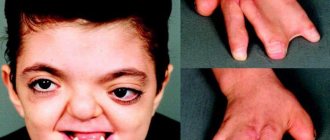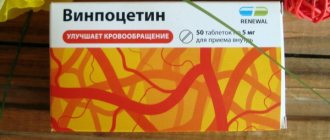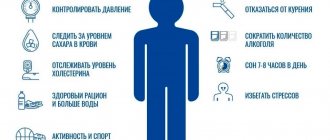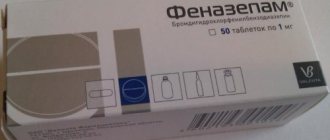Comparison of the effectiveness of Afobazole and Phenazepam
Phenazepam is more effective than Afobazole - this means that the ability of the drug substance to provide the maximum possible effect is different.
For example, if the therapeutic effect of Phenazepam is more pronounced, then with Afobazole it is impossible to achieve this effect even in large doses.
Also, the speed of therapy is an indicator of the speed of therapeutic action; Phenazepam and Afobazole are also different, as is bioavailability - the amount of a drug substance reaching the site of its action in the body. The higher the bioavailability, the less it will be lost during absorption and use by the body.
What to choose?
Both drugs belong to the group of tranquilizers, but have completely different compositions . Phenazepam is available in the form of tablets and solution for injection. Afobazole is available only in tablet form.
The indications for the use of the drugs are almost the same . They are prescribed for various anxiety conditions. As for contraindications, they are completely different. They need to be taken into account when choosing a medication. Both products are prohibited for use by children, pregnant and lactating women.
Another distinctive feature is that Phenazepam has a muscle relaxant effect . This means that in addition to relieving stress, a person’s muscles will relax and he will fall asleep. From this we can conclude that after taking the drug you should not engage in activities that require concentration, or drive. Afobazol does not have such phenomena. It does not cause drowsiness and after taking it you can drive a car and do various jobs. This reaction is due to selective action. Also, when taking Afobazole, nerve cells become more resistant to stressful situations in the future.
The fact that Afobazole does not cause drowsiness is its main advantage. Phenazepam is considered a stronger drug. It has a strong enough effect that it is prescribed only by prescription. Serious indications are required to take it. It also has a large number of contraindications and side effects. With long-term use it can be addictive, and with sudden use. Therefore, you should drink it only under the supervision of a doctor.
These medications have slightly different purposes . Phenazepam is recommended for elderly people who have sleep problems. It works almost immediately. It is quite cheap, but is sold only by prescription. Afobazole has a milder effect, is freely sold, but has a higher cost. To get a good effect, you need to take it for at least a month.
The cost of Afobazol is about 450 rubles for 60 tablets . The cost of Phenazepam is no more than 100 rubles .
Comparison of the safety of Afobazole and Phenazepam
The safety of a drug includes many factors.
At the same time, in Afobazole it is quite similar to Phenazepam. It is important where the drug is metabolized: drugs are excreted from the body either unchanged or in the form of products of their biochemical transformations. Metabolism occurs spontaneously, but most often involves major organs such as the liver, kidneys, lungs, skin, brain and others. When assessing the metabolism of Afobazole, as well as of Phenazepam, we look at which organ is the metabolizing organ and how critical the effect on it is.
The risk-benefit ratio is when the prescription of a drug is undesirable, but justified under certain conditions and circumstances, with the obligatory observance of caution in use. At the same time, Afobazole does not have any risks when used, just like Phenazepam.
Also, when calculating safety, it is taken into account whether only allergic reactions occur or possible dysfunction of the main organs. In other matters, as well as the reversibility of the consequences of the use of Afobazole and Phenazepam.
Cancel phenazepam
Hello, Anatoly!
My name is Ekaterina, I’m 32 years old, I’m from the near Moscow region. For the second year now I have been taking phenazepam no more than one tablet a day. In 2011, I had my first panic attack on the street, then at home. The ECG during the attack showed only sinus tachycardia. My blood pressure always rises to 150 due to nervous tension.
At the ambulance they gave me phenazepam under the tongue, Corvalol and valerian. They said that nerves and hidden emotions .
I always keep everything to myself, but I had enough stress. So the vegetation “limped”. My brain remembered my first PA, and off we went. Now I even have a phobia of the blood pressure monitor; when I pump air into it, my pulse is already under 120. That’s why I haven’t measured my blood pressure for six months.
But my stable has always been 115 to 75.
I haven't had a panic attack for eight months now. But after them there was an unpleasant feeling in the area of the apex of the heart, like emptiness, or a tugging, or a feeling of some kind of non-existence. This is felt only at rest; if you go for a run, do physical work, it all goes away. I probably already have cardioneurosis.
For six months I drank afobazole, persen, novopassit, tenoten, relaxosan, glycine forte, magnesium B6, Corvalol, valerian, read Kurpatov, read the entire website about VSD. NOTHING HELPED. As soon as I take phenazepam, it seems to me that I am “healthy”.
And this discomfort in the left side of the chest of a psychogenic nature, as the psychotherapist told me, I can only relieve with phenazepam. I read your article “Withdrawal of Phenazepam” and lasted five days without the medicine.
On the fifth day in the morning, my whole body felt unpleasant, as if my blood pressure had dropped and I felt terrible weakness.
And then fear appeared again, my heart began to beat, and blood rushed to my head. I took phenazepam under my tongue, and after an hour everything went away. I probably already have endogenous depression , I’m suffering from cardioneurosis, and at the slightest excitement my pulse quickens.
The psychotherapist advises taking Paxil. I haven’t tried it yet, they say there are all sorts of side effects, but it helps someone, I want to try it. After all, sometimes there was even such fear that I couldn’t go outside with the child. And now I can do everything, but only with phenazepam, and I drink it only because of this incomprehensible feeling in the heart area, this feeling is really bothering me. But the most interesting thing is when you don’t focus on yourself and there is no feeling of it. I was very fixated on my condition. An incomprehensible fear, now I’m afraid to die, now I’m afraid of my heart, but it’s like a Swiss watch, it works and works, and I’m afraid. Life was divided into two parts, before and after panic disorder. So I’m taking phenazepam, I don’t know what to do? The panic disorder has gone away, but this feeling in the heart area remains, or it really is already depression. Maybe try Paxil? I will be grateful to you for your answer. Best regards, Ekaterina. (If I stop taking phenazepam, I will hardly be able to withstand bodily pain without it).
Answer to the question:
How to relieve tension in the nervous system?
From your story I understand that now the general condition is satisfactory. The panic attack is in the past, only minor discomfort in the heart area remains. But this is observed only under one condition. Constant use of phenazepam is required.
But everything suggests that, despite taking a tranquilizer, the nervous system is experiencing overexcitation.
Such strange phobias as fear of doctors, people in white coats, the sound of an ambulance siren and fear of a medical examination, even the most harmless one, indicate extreme tension in the nervous system.
There are two ways to relieve tension in the nervous system.
The first is taking psychotropic medications. You can take tranquilizers, such as phenazepam. But you need to take it regularly and constantly. The daily dose is small, the therapeutic effect is fast and there are minimal side effects.
Although doctors and the instructions for the drug do not advise taking phenazepam for more than one month, most people with panic disorder are saved in this way. You are also on this list. Antidepressants have a slightly different effect on the human nervous system.
A huge number of side effects, especially in the first weeks of treatment, when all the symptoms intensify. And as a result, after treatment, the disease remains with the person.
Therefore, you need to perceive psychotropic medications not as a means of eliminating panic disorder, but as an opportunity to give your nervous system a break for a while. Give her the opportunity to soberly assess her condition and work on eliminating her fears on her own. I have a negative attitude towards antidepressants.
The second way is to work with your own thoughts and attitudes. Why did you have an attack of PA after stopping phenazepam on the fifth day? Phenazepam has the property of accumulation in the body.
It is on the fifth day that the concentration of the drug in the body decreases below the required therapeutic level, and the body is left without outside support. He remains on his own against his panic disorder.
The fear of death begins to take precedence over everything else and everything returns to normal. You just need to accept the idea that a person does not live forever and come to terms with it. It sounds simple, but buried in this statement is an attitude towards the disease and the opportunity to recover.
Only by coming to terms with your fear of death can you gradually recover. This is the only right direction.
phenozepam under the tongue . Its action is the same when taken orally and sublingually.
And the conversation that you can’t stand it without phenazepam is a little exaggerated in your imagination, in your thoughts. Convince yourself of the opposite and everything will work out for you. Anyone who survives one panic attack is already a hero.
I am 32 years old, male, married. A couple of months ago I had trouble and suffered prolonged stress. There was a feeling of anxiety, an incomprehensible fear out of nowhere, a feeling of hopelessness during the day. It appears mainly in the morning after breakfast, but it also occurs at other times of the day.
For almost a month I drank different herbal decoctions, all possible tinctures, glycine. There was no tangible help. The psychiatrist prescribed Phenazepam 1/4 3-4 times a day. She said that it is better to take a little at a time, but more often and only when this anxiety appears, she said that there should be no addiction from such a dosage.
I started drinking 1/4 only in the morning when she covers it. The anxiety disappears and becomes much better, but it’s not always until the end, sometimes there is a little left, then after 1-2 hours I drink a quarter.
I do not take phenazep all the time, but only as needed.
I can drink it for 4 days every day, and then for 2-3 days I don’t even look in its direction, I take it shorter as needed. So far I don’t see any addiction, there is no weakness or drowsiness. On the contrary, after I take 1/4 of the tablet, I become more cheerful because I stop being afraid.
It’s a pity that it doesn’t always work, and it’s scary to increase the dose. And I don’t have the strength to stop drinking it. Please advise what to do? Thank you.
Answer to the question:
How to take phenazepam
Based on this scant information, you are suffering from anxiety, sleep disturbances and minor panic attacks. What saves you is that you always have the right medicine at hand. In this case it is phenazepam.
This situation appeared suddenly and only two months ago. This is a very short period of time for VSD, which means the case is not advanced. If medicinal herbs with glycine do not help, then it was necessary to go in ascending order. Try taking adaptol first and then gidazepam.
They are much weaker and have fewer side effects.
The fact that you take phenazepam for 3-4 days and then go without it for a couple of days is very bad. Phenazepam tends to accumulate in the body. After its abrupt withdrawal, alarming symptoms may appear within 3-5 days, and suddenly, against the background of complete happiness. During this time, the accumulated medicine has time to leave the body and its concentration becomes less than therapeutic.
You are violating the drug dosage regimen. First, a dose is prescribed that completely removes all signs of anxiety and panic; this is 1-3 tablets per day. At this dose, the drug is taken regularly and continuously for 10 to 20 days. It is necessary to achieve complete disappearance of the symptoms of VSD and panic disorder.
Then they begin to reduce the daily dose of the drug by 1/4 of the tablet once every week. You can stay at a dose that maintains a normal state for several months without any consequences. Some patients take small doses of phenazepam or other tranquilizers continuously for many years. So, gradually reduce the dose and go off the drug.
But you need not only pills, but also yourself to overcome the fear of death in your head. Read this article carefully.
Source: https://vsd-lechenie.com/zadat_vopros_psihoterapevtu/85-otmena-fenazepama.html
Comparison of addiction between Afobazole and Phenazepam
Like safety, addiction also involves many factors that must be considered when evaluating a drug.
So, the totality of the values of such parameters as “syndrome o” for Phenazepam is less than the similar values for Afobazole. Withdrawal syndrome is a pathological condition that occurs after the cessation of intake of addictive or dependent substances into the body. And resistance is understood as initial immunity to a drug; in this it differs from addiction, when immunity to a drug develops over a certain period of time. The presence of resistance can only be stated if an attempt has been made to increase the dose of the drug to the maximum possible.
Afobazole
The active ingredient is afobazole . Available in tablet form. Belongs to the group of tranquilizers .
The drug has a calming and mild stimulating effect. Due to this, the feeling of fear, anxiety, and panic attacks is reduced. It also eliminates the consequences of various specific conditions, for example, withdrawal syndrome.
Patients should especially take the drug if:
- Suspiciousness.
- Increased vulnerability.
- Sudden mood swings.
- Uncertainty.
Well absorbed from the gastrointestinal tract. The half-life is approximately one hour.
The therapeutic effect can be observed 5-7 days after the start of treatment. The maximum effect is observed after 3-4 weeks of use.
Afobazole is prescribed for:
- Anxious states that are accompanied by a feeling of anxiety.
- Anxiety disorders.
- Sleep disorders.
- Neurocirculatory dystonia.
- PMS in women.
- Alcohol withdrawal.
- Withdrawal syndrome.
The drug is contraindicated in:
- Individual intolerance.
- Galactosemia.
- Monosaccharide intolerance.
- Lactase deficiency.
- Under 18 years of age.
- Pregnancy.
- Breastfeeding.
The drug should be taken after meals. The dosage and duration of administration are determined by the doctor.
Comparison of side effects of Afobazole and Phenazepam
Side effects or adverse events are any adverse medical event that occurs in a subject after administration of a drug.
Phenazepam has more adverse effects than Afobazole. This implies that the frequency of their occurrence is low with Phenazepam and low with Afobazole. Frequency of manifestation is an indicator of how many cases of an undesirable effect from treatment are possible and registered. The undesirable effect on the body, the strength of influence and the toxic effect of drugs are different: how quickly the body recovers after taking it and whether it recovers at all. When using Phenazepam, the body's ability to recover faster is higher than that of Afobazole.
Phenazepam
The active ingredient is bromodihydrochlorophenylbenzodiazepine . Available in the form of tablets and ampoules with injection solution. Belongs to the group of tranquilizers.
Phenazepam is a psychotropic drug that can reduce fear, panic attacks, anxiety and emotional stress. Has the following effects:
- Anxiolytic.
- Sedative.
- Sleeping pills.
- Muscle relaxant.
- Anticonvulsant.
- Amnestic.
The drug has a calming effect on the central nervous system , thereby reducing signs of depression and panic attacks.
Well absorbed from the gastrointestinal tract. The maximum concentration is observed 1-2 hours after administration . The half-life is 6-18 hours , depending on the characteristics of the human body.
The drug is prescribed for:
- Neuroses.
- Psychosis.
- Sleep disorders.
- Hypochondriacal syndrome.
- Epilepsy.
- Panic attacks.
- Increasing muscle tone.
- Unstable mental state.
- Withdrawal syndrome.
There is also information that the drug is approved for use in preparation for surgical interventions.
Contraindications are:
- Shock and coma.
- Myasthenia.
- Closed glaucoma.
- COPD
- Respiratory failure.
- Pregnancy and lactation period.
- Children under 18 years of age.
- Individual intolerance to the drug.
Patients with liver and kidney failure should take the drug under strict medical supervision.
Comparison of ease of use of Afobazol and Phenazepam
This includes dose selection taking into account various conditions and frequency of doses. At the same time, it is important not to forget about the release form of the drug; it is also important to take it into account when making an assessment.
The ease of use of Afobazole is approximately the same as that of Phenazepam. However, they are not convenient enough to use.
The drug ratings were compiled by experienced pharmacists who studied international research. The report is generated automatically.
Last update date: 2020-12-13 10:31:29
Conclusion
Thus, it is quite difficult to say which drug is more effective. Both are quite strong tranquilizers . Phenazepam is prescribed by prescription. It is not suitable for long-term use, but has a stronger effect. Afobazole is suitable for daily use; its therapeutic effect is also good, but the patient may not be afraid of drowsiness or a large number of side effects. In any case, the choice of drug should be made by a doctor , since it is not recommended to take these drugs without the supervision of a doctor.
Medicine and healthComment
results
DPP-4 activity and MDA content in patients with TR and the effect of Afobazol and Phenazepam on them
In Fig.
Table 1 shows summary data on the activity of DPP-4 and the content of MDA in the blood plasma in the studied patients compared with healthy volunteers.
Both biochemical parameters in patients with TR of the studied structure were significantly (at p<0.01) higher than their values in healthy volunteers. The average values of DPP-4 activity in 92 patients were 5.13±1.21 nmol/ml/min compared to 2.84±0.57 nmol/ml/min in the control group, and the concentration of MDA in patients was 1.21 ±0.39 (n=68) compared to 0.55±0.1 in the control group. At the same time, when analyzing the relationship between DPP-4 activity and MDA concentration in the studied population of patients and the control group, as can be seen in the scatter diagram (Fig. 2),
a significant correlation between both parameters is revealed (r=0.545; p<0.001; n= 68). It is important to note that, according to the results of two-week use of the anxiolytics Afobazole at a dose of 30 mg and Phenazepam at a dose of 2 mg, both biochemical parameters retained significant differences from their values in healthy volunteers.
Data on therapeutic changes in DPP-4 activity in patients with TR when using Afobazole in a daily dose of 30 mg are given
in Table.
2. Analysis of the dynamics of DPP-4 activity during its total assessment in the entire patient population showed a virtual absence of changes over 14 days of drug therapy.
However, therapeutic changes in enzymatic activity differed in patients of different diagnostic subgroups. In patients with GAD, there was an insignificant increase in enzyme activity on the 7th and 14th days of the study, in patients with TGF - a statistically significant decrease, and in patients with TID - the levels remained almost stable on the 7th and 14th days. At the same time, changes in DPP-4 activity by day 14 in patients with GAD and TGF differed at the level of a trend toward statistical significance (p = 0.09). However, a detailed analysis revealed a fundamentally important individual variability in changes in DPP-4 activity under the influence of Afobazole in the studied patients, with both an increase (n = 22) and a decrease (n = 28) noted. It was found that an increase in DPP-4 activity under the influence of Afobazole occurred in patients with low background values, and a decrease in those with initially high levels ( Fig. 3
; differences in background values are statistically significant); p<0.01. This pattern is confirmed by a significant correlation between the initial activity of DPP-4 in patients with TR and its change after 14 days of therapy.
Afobazole had a more clear effect on the MDA content in the blood plasma of patients, reducing this indicator according to the results of two-week therapy in 29 out of 32 patients
(Fig. 4)
[21].
A different picture was observed with the use of Phenazepam. Its use was associated with a stable decrease in DPP-4 activity (in 33 of 36 patients), with greater individual variability in changes in MDA content compared to Afobazole (increase in content in 9 patients, decrease in 27); see fig.
4 [15, 21]. Thus, Afobazole led to a stable decrease in MDA content, which correlates with ideas about its mechanisms of action, while the activity of DPP-4 changed in different directions and depended on its background level. Phenazepam led to a decrease in both biochemical parameters, more stable in relation to DPP-4 and less stable in relation to MDA. The fact that drugs effective against TP with different mechanisms of action have different effects on DPP-4 activity highly likely indicates that this indicator in itself is not an epiphenomenon of anxiety.
Analysis of clinical and biochemical relationships between indicators of DPP-4 activity and MDA content with the parameters of the condition of the studied patients
When conducting a correlation analysis of biochemical parameters with parameters of the patients’ condition before the start of therapy, assessed using different methods, a number of reliable weak relationships were identified. The content of MDA in the blood plasma significantly correlated with the duration of the disease (r=0.33; p=0.009; n=92) with increased exhaustion according to the WDS scale (r=0.41; p=0.025; n=92). DPP-4 activity in blood plasma was significantly associated with the severity of RF (r=0.27; p=0.048; n=92), daytime sleepiness (r=0.28; p=0.044; n=92), the average score of the anxiety cluster violations on the SHOVS scale (r=0.24; p=0.025; n=92) and total score on the HAMA scale (r=0.24; p=0.026; n=92). Taking into account the variability in the dynamics of enzymatic activity identified during the use of Afobazole, depending on its background levels, clinical differences in patients with different variants of the dynamics of DPP-4 activity are of interest. It was found that patients with initially lower levels of DPP-4 activity with its subsequent increase were characterized by a lesser severity of psychopathological symptoms compared to patients who had high background levels of activity with its subsequent decrease (average score for the cluster of anxiety symptoms on the SHOVS scale: 2.23 and 2.81, respectively, p=0.009, n=51; average score for the cluster of neurotic symptoms: 0.84 and 1.33, respectively, p=0.065, n=51). At the level of individual symptoms, significant differences were noted in relation to increased irritability, affective lability, awakening disorders, ideational obsessions, phobias and psychovegetative symptoms (arterial hypertension and paroxysmal autonomic disorders).
The relationship between background indicators of DPP-4 activity and MDA content with the dynamics of clinical parameters when using Afobazol and Phenazepam
When studying the relationship between background DPP-4 activity, significant correlations were found with changes in daytime sleepiness on days 7 and 14 (D0 - Dn, where D0 are background values, and Dn are values on days 7 or 14; R = 0.39, p=0.003 and R=0.28, p=0.039, respectively, n=51). This relationship is especially clearly seen among patients with TIR (R=0.82, p<0.001 and R=0.53, p=0.02, on days 7 and 14, respectively, n=17). In addition, in patients with TGF (n = 18), a significant correlation was revealed between the background activity of DPP-4 and the dynamics of asthenic disorders on the 7th day of therapy (R = -0.48, p = 0.041), and at the level of a trend - with therapeutic changes by the 7th and 14th day in the severity of hypothymia and associated symptoms (R=-0.41, p=0.088 and R=-0.46, p=0.054, respectively, on the 7th and 14th day). In patients with GAD (n=16), a relationship between DPP-4 activity before the start of therapy and the dynamics of sleep disturbances on the 14th day was revealed at the level of a trend towards statistical significance (R=0.46, p=0.064). When assessing the relationship between the MDA content before treatment and changes in mental state indicators when using Afobazole in all patients, regardless of diagnosis, relationships were identified with the severity of changes in the TR cluster (r = 0.368, p = 0.045), asthenic disorders (r = 0.45 , p=0.013) and total anxiety score on the HAMA scale (r=0.419, p=0.021). In the Phenazepam therapeutic group, regardless of diagnosis, the initial levels of DPP-4 activity did not show a correlation with changes in state indicators, and the MDA content correlated only with changes in the severity of daytime sleepiness (r = -0.433, p = 0.008).
The relationship between the background activity of DPP-4 and the content of MDA with the effectiveness of treatment with TR Afobazol and Phenazepam
A weak correlation was revealed between the background activity of DPP-4 and the effectiveness of therapy according to the CGI “Therapeutic Effect” scale in all studied patients with TR (R = 0.28, p = 0.046, n = 51). In addition, at the level of a trend toward statistical significance, relationships were established with indicators of other subscales of the CGI scale on day 14 (with severity of illness: R = 0.27, p = 0.053; with overall improvement: R = 0.25, p = 0.071 ). A similar correlation was found for the subjective performance parameter (R=-0.29, p=0.036). At the same time, in patients with GAD, in whom Afobazol is most effective, the correlation coefficient with the CGI indicators “Therapeutic effect” increased to 0.47 (p = 0.053), and with the effectiveness of course therapy subjectively assessed by patients – to -0.56 (p = 0.02). At the same time, in the groups of patients with TFR and TIR, no significant correlations with CGI scale indicators and subjective assessment of effectiveness were detected. The positive nature of the correlations with the CGI scale indicators and the negative one with the subjective assessment indicators indicates that the lower the initial level of DPP-4 activity, the higher the effectiveness of therapy and the lighter the severity of the condition on the 14th day of treatment. In order to verify the identified correlations between the background activity of DPP-4 and the effectiveness of therapy, the sample of patients studied was classified according to the effectiveness of therapy on the CGI “Therapeutic Effect” scale into patients with high effectiveness (1 and 2 points on the scale) and low effectiveness (3 and 4 points on the scale). When comparing these two groups of patients, statistically significant differences in DPP-4 activity before treatment were revealed (4.94 and 5.64 nmol/ml/min in patients with high and low therapeutic effect); p=0.015. Similar statistically significant differences were revealed when assessing patients with GAD (4.62 and 6.10 nmol/ml/min in patients with high and low therapeutic effect); p=0.015. Background MDA activity did not correlate with any of the indicators of the effectiveness of therapy when using Afobazole. In addition, background values of DPP-4 activity or MDA content did not show a relationship with the results of Phenazepam therapy either in all treated patients or in diagnostic groups.
Taking into account the obtained data on the relationship between the initial activity of DPP-4 and the effectiveness of Afobazole therapy, a regression analysis using the binary logistic regression method was carried out to assess the contribution of this indicator to the effectiveness. At stage I, using the “Automated Linear Modeling” procedure (direct step-by-step method), into which indicators of high (1 and 2 points) or low (3 and 4 points) therapeutic effect on the CGI “Therapeutic Effect” scale were entered as a dependent variable To create a standard model, the most significant independent variables of the background condition of patients were identified among the following: DPP-4 activity, MDA content in blood plasma, total score on the HAMA scale, score on the CGI “Disease Severity” scale, average scores for symptom clusters reflecting pharmacological effects of drugs on the SHOVS scale (TR, depressive disorders, asthenic disorders, sleep disorders, level of vigor, neurotic disorders, vegetative disorders). According to the results of this analysis, only two indicators had statistical significance: DPP-4 activity and the total score on the HAMA scale. Based on the results of introducing these variables into the regression model using the binary logistic regression method, a significant model was obtained (c2 = 15.37, df = 2, p = 0.0005). The regression equation has the following form: p=1/1 + e8.77 - (0.916×DPP-4) - (0.171×HAMA), where p is high or low effectiveness of therapy. The prediction error using this regression equation was 28.3%. In Fig.
Figure 5 shows graphs of the probability of a high or low therapeutic effect of Afobazole depending on the initial activity of DPP-4 in all patients and patients with GAD (Naive Bayes Classifiers method). If, when analyzing all patients (n=51), the probability of a high therapeutic effect was 45.0%, then in patients with background DPP-4 activity <4.75 nmol/ml/min (n=17 out of 51), the probability of favorable treatment outcomes exceeded 65%. In the GAD group, this borderline value of background DPP-4 activity allows us to identify a subgroup of patients (n=7 out of 18), in whom a high therapeutic effect is achieved with more than 90% probability compared to 62.5% in all patients with GAD (n= 18).
Discussion and conclusion
The provisions of the draft new biologically based classification of mental disorders (RDoC) call into question the validity of the nosological systems based on syndromological characteristics that dominate clinical practice. Instead of studying cases that clearly correspond to the nosological definitions of a particular disorder, they propose studying a biologically determined phenomenon per se in connection with indicators from related fields. This study was conducted in accordance with the stated RDoC guidelines. The study confirmed data on an increase in DPP-4 activity and MDA content in the blood plasma in patients with different TR compared with healthy volunteers. Correlations of both biochemical parameters with some clinical characteristics of the condition were found. However, if the relationship between the content of MDA in the blood plasma, reflecting the activity of lipid peroxidation processes, and the duration of the disease/severity of asthenic disorders seem to be natural [9], then the relationship between the activity of DPP-4 and the severity of TGF requires a separate analysis. Such an analysis was carried out by studying and comparing the dynamics of both indicators under the influence of two drugs effective in the treatment of TR, which have fundamentally different basic mechanisms for realizing their therapeutic effect. The classic benzodiazepine anxiolytic Phenazepam in most cases leads to a decrease in MDA content and DPP-4 activity. A decrease in MDA levels during benzodiazepine therapy has been previously described in the literature [10]. Afobazole, which belongs to the class of membrane modulators, causes both an increase and a decrease in DPP-4 activity when the MDA content decreases. At the same time, a pattern was revealed that an increase in enzyme activity is observed in the group of patients with TR with relatively lower initial levels of DPP-4 activity in the blood plasma, and a decrease, on the contrary, in the group with relatively higher background values. It should be noted that the enzyme activity indicators before the start of therapy in these groups were statistically significantly different. The fact that drugs that are effective against TR and have different mechanisms of action have different effects on the activity of DPP-4 indicates that with a high degree of probability this indicator in itself is not an epiphenomenon of anxiety. Thus, the identified features of DPP-4 activity in patients with TR and the influence of the anxiolytic Afobazole, effective in clinical conditions, on it in the form of a modulating effect with a decrease in relatively high and increase in relatively low values of enzyme activity indicate that, probably, regulation of the state of the endopeptidase system , and perhaps more general pathological changes occur in these patients at a level different from healthy individuals, which is a consequence of pathological adaptation (allostasis). One of the possible interpretations of the observed changes may be that increased levels of MDA in the blood plasma, apparently, to a greater extent characterize general pathological changes in patients with TR (achievement of allostasis, the very fact of the involvement of lipid peroxidation in the pathogenesis), associated with the progression of the disease process ( this, in particular, explains the detected connections with the overall duration of the disease and a decrease in the level of vigor [21] and correlates with the literature data on the role of lipid peroxidation processes in the pathogenesis of TR [9]). However, DPP-4 activity, due to its heterogeneity, which is associated with the severity of anxiety and neurotic disorders to a greater extent, appears to be associated with certain aspects of the overall severity of the condition within the framework of the achieved allostatic equilibrium. In addition, data have been obtained that when using Afobazole, but not Phenazepam, a relationship is revealed between the background activity of DPP-4 and several parameters reflecting the effectiveness of therapy. Moreover, this relationship is strengthened in patients with GAD, in whom Afobazole is most effective. Along with this, data were obtained that the indicators of DPP-4 activity and the total score on the HAMA scale before the start of therapy are predictors of the results of two-week use of Afobazole in patients with different TR, and especially in a narrower group of patients with a relatively simple structure of the syndrome within GAD , and taking into account the initial enzyme activity with a borderline value of 4.75 nmol/ml/min allows improving the expected prognosis of therapy by 20–30%. However, this data needs to be replicated. A separate discussion requires data on the association of the high effectiveness of Afobazole with an increase, rather than a decrease, in DPP-4 activity, although in patients with TR it is already statistically significantly higher than in healthy volunteers. To explain the apparent contradictions, we formulated a simplified mechanistic hypothesis (Fig. 6),
based on the modern understanding of the pathogenetic significance of LPO processes in the genesis of TR and the known mechanisms for the implementation of the anxiolytic effect of Afobazole: 1. LPO processes are involved in the pathogenesis of TR [26, 27] and are realized in cell membranes by chain reaction mechanisms, causing their continuously expanding damage [28]. 2. DPP-4 is a transmembrane protein, and damage to the cell membrane can lead to disruption of the anchoring of its outer fragment, which retains enzymatic activity, which can lead to the release of an additional fraction of the enzyme into free circulation and an increase in its activity in plasma. 3. The identified relationships between the activity of DPP-4 and the severity of anxiety, as well as between the content of MDA and the duration of the disease, may indicate that different degrees of damage to cell membranes correspond to pathologies of different depths of damage. 4. As a consequence, it seems logical that the less pronounced and less durable the pathological condition, the more preserved the membranes are, and the less the anchoring of the outer fragment of DPP-4 is disturbed and, therefore, the less of its excess quantities enters free circulation. And, conversely, a more severe and protracted pathological condition is accompanied by more pronounced membrane changes, impaired DPP-4 anchoring and its facilitated release into the blood plasma. 5. One of the most significant mechanisms of action of Afobazole is the activation of s1 receptors [20], causing migration of lipid microdomains from the rough endoplasmic reticulum to the cell membrane with subsequent fusion with it, replacing sections of the plasmalemma, which in turn can lead to a reduction in the area of the caused FLOOR of membrane damage. 6. This may ultimately lead to a decrease in the content of lipid peroxidation products in the blood plasma, which corresponds to both the data obtained in the study on the decrease in MDA content during Afobazole therapy and the results of experimental studies [29]. 7. In the case of more pronounced disturbances in the membrane structure (theoretically associated with a more severe condition), the anchoring of DPP-4 is impaired to a greater extent, therefore, less DPP-4 is anchored on the membrane and a relatively larger amount is in the systemic circulation. The incorporation of lipid microdomains into a damaged membrane under the influence of Afobazole can lead to its “stabilization” and a gradual decrease in the facilitated entry of DPP-4 into the blood plasma, and, consequently, a decrease in the activity of the enzyme in the plasma. 8. In a situation of less pronounced damage to the plasmalemma (i.e., theoretically, with less severity of the condition), when a relatively large amount of DPP-4 remains attached to the cell membrane, and relatively lower concentrations are in circulation, the fusion of new lipid microdomains with the cell membrane when treated with Afobazole, it can potentially lead to increased release of DPP-4. Nevertheless, this hypothesis needs confirmation. Its validity could be supported by data on a more clear decrease in the activity of DPP-4 with an increase in the dose of Afobazole and/or the duration of its use. In addition, a better understanding of the observed changes could be facilitated by studying the dynamics of DPP-4 activity when administered with other membrane modulators, antioxidants, and anti-inflammatory drugs.
conclusions
1. In patients with TR, the MDA content and DPP-4 activity in the blood plasma are increased. 2. The drugs Afobazole and Phenazepam, which have different mechanisms of anxiolytic action, cause a decrease in the content of MDA in the blood plasma. 3. Afobazole and Phenazepam have different effects on the activity of DPP-4: the classic benzodiazepine anxiolytic Phenazepam in most cases leads to a decrease in the activity of DPP-4. Afobazole, which belongs to the class of membrane modulators, causes an increase in enzyme activity in patients with TR with relatively lower background levels of DPP-4 activity in the blood plasma, and a decrease in those with relatively higher ones. 4. The activity level of DPP-4 before the start of therapy below 4.75 nmol/ml/min is a predictor of high therapeutic results of two-week use of Afobazole in patients with TR. Information about the authors Syunyakov Timur Sergeevich
– Ph.D.
honey. Sciences, Art. scientific co-workers lab. wedge. Psychopharmacology Federal State Budgetary Institution "Research Institute of Pharmacology named after. V.V. Zakusov.” E-mail Neznamov Grigory Georgievich
– Dr. med.
Sciences, prof., deputy. dir. according to scientific work, manager lab. wedge. Psychopharmacology Federal State Budgetary Institution "Research Institute of Pharmacology named after. V.V. Zakusov.” E-mail Nikolay Nikolaevich Zolotov – Ch. scientific co-author, Dr. Biol. sciences, prof. lab. Psychopharmacology Federal State Budgetary Institution "Research Institute of Pharmacology named after. V.V. Zakusov.” Email









